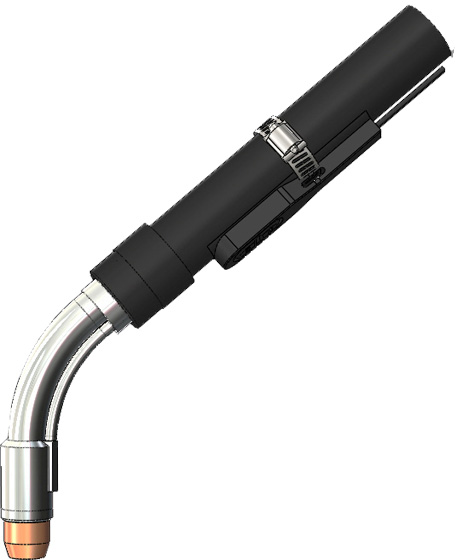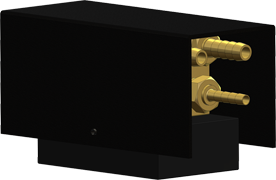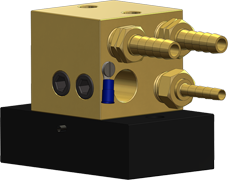
Water-Cooled NCC P-38 Gun
(7/16"-3/4" Gas Cup ID)
Drawings Accessories More Info
Overview
These W/C Curved Guns are extremely heavy duty and rugged and built for production welding. If you are tired of the problems associated with Water-Cooled and Air-Cooled guns (throw away) such as Bernard, Binzel, Profax, Fronius, Miller, Lincoln, ESAB, Tweco, Tregaskiss, American Torch Tip, the NCC-P38 is a far superior welding gun, designed to last years instead of months. Unlike the other welding gun manufacturers mentioned, these D/F hand guns are built with copper, not plastic, have water cooling on the gas nozzle and tip, have a water cooled power cable, and can run any size and kind of welding wire. The NCC-P38 50 degree water cooled gun, part #36800, is a rugged all purpose, water cooled, manual MIG welding torch designed to operate at welding currents up to 600 amps in CO2 and 500 amperes continuous duty using argon as the shielding gas. The NCC-P38 is intended for use with all manufacturers wire feeders which have provision for water cooling and will handle all types of welding wires in sizes from .035"-1/16" Steel, 3/64”-3/32” Aluminum. It accommodates a slip-in tip fastened by a collet action nut. A unique feature of this Water-Cooled Curved Gun is that the nozzle assembly water chamber and inner body water chamber are serially connected to each other with sliding removable connectors making it a relatively simple matter to detach the nozzle assembly, thus completely eliminating the need for gaskets in the water passage system. The 50-degree, curved metallic water-cooled front body allows for operation in tight, hard-to-reach areas. The torch has a copper gas nozzle, which threads into the copper front end of the torch for better heat dissipation. The slip-in contact tip is threadless and is retained by a collet action nut for easy removal and insertion of a new tip . All utilities are connected internally to the torch body and exit from the rear of the torch body housing. We also offer an optional cable/hose sheath for better cable management. The torch is provided with a button switch which can be positioned at any point on the torch handle. For feeding all wires, a replaceable liner conduit system is available for feeding 0.35, .045, .047, .052, and 1/16-in. hard/cored wires through a continuous metal liner run to the tip in the gun with no gaps. For aluminum welding of 3/64, 1/16 and 3/32-in. wires run through a continuous Nylatron liner run to the tip in the gun with no gaps. These D/F Machine Specialties Water-Cooled Curved Guns are designed to be run at 100% duty cycles, upwards of 650 amps.
Remember the great ESAB ST-16 torch (part no. 997498) welding gun that was used exclusively for gas metal arc (MIG) spot welding of aluminum and hard wires? Very similar in design to the ESAB ST-16 welding gun but with improvements and new features, and proven to be a superior replacement alternative, the D/F water-cooled handheld curved MIG push gun is a rugged, all purpose, water-cooled, manual MIG welding torch designed to operate at welding currents up to 400 amperes on a true continuous duty cycle using all types of shielding gases. Like the ESAB ST 16, the D/F Curved Gun is easily connected to the ESAB MIG-35 wire feeder. The DF curved MIG gun is also intended for use with all wire feeders which have provision for water cooling. It is designed to run wire with diameters up to 3/32".
The D/F torch is famous for the fact, that if it is chilled properly, the welder can grab the chrome front water-cooled barrel (not the copper gas nozzle/cup) of the torch with their bare hand and it will be cold to the touch seconds after welding. With the proper chiller, this can be done even after a 4 hour arc time. Make certain the cooling water supply is at least the minimum flow rate of 1 gallon per minute (for each inner body), at 40 psi (80 psi maximum) with a 6 gallon reservoir and a recommended 30,000 BTU/hr cooling capacity. Gun ratings are affected by shielding gas used, arc time, cooling time and inlet water temperature. Water outlet temperature should not exceed 27°C (80°F). The torch’s water out & power cable is not cooled until the coolant has gone through the torch and out the water out & power cable. If water is not flowing through the D/F torch for at least 1 minute prior to striking an arc, when you apply the power and water hits the “hot” water/out & power cable, you will generate steam. Steam can damage the torches internals in seconds causing a leak. It can also blow out the torches water/out & power cable. A flow switch can be installed after the return line ensuring that coolant is present at the return line prior to striking an arc. When High-Deposition GMAW, high current density, high amperages, preheat, or extended periods of arc time are used, a refrigerated liquid chiller with a larger reservoir is required. Precise temperature control maintains the cooling at a constant 13°C (55°F) temperature, thus prolonging the life of the welding equipment and more specifically extending the service life of the gas nozzle and current tip. D/F Machine Specialties does not manufacture or sell chillers, we only recommend them. Click here to see our recommended chillers.
Each D/F Machine Specialties welding gun is fully assembled and ready to install. In order to make the installation complete, the code number, wire size, wire feeder make/model (Lincoln wire feeders, Miller wire feeders, Tweco wire feeders, ESAB wire feeders, & EURO Quick Disconnect wire feeders), and inlet (as needed) must be specified when ordering. If special welding tools or accessories other than those listed previously are required, please consult with the factory. Get the right feeder adapter connection to fit your MIG wire feeder.
Features
- Water-Cooled Inner Body & Nozzle
- Small Frontal Area for Hard-to-Reach Locations
- 360° Positionable Trigger Switch
- .035"-1/16" Steel, and 3/64”-3/32” Aluminum
- Designed to operate at welding currents up to 600 amps CO2 and 500 amps Ar at 100% Continuous Duty Cycle.
Model Explanation
- NCC-P-38 - Normal Duty, Collet Action (Slip-in Current Tip), Curved Gun
Model Specifications
| MODEL | CURRENT CAPACITY |
WEIGHT (APPROX.) |
COOLING REQUIRED |
RECOMMENDED WIRE DIA. RANGE |
INSTRUCTION MANUAL |
|---|---|---|---|---|---|
| NCC-P-38 | 650 amps @ 100% Duty Cycle |
2.5 lbs | 3 quarts/min | .030"-3/32" Hard/Cored, 3/64"-3/32" AL |
NCC-P38 |
Barrel Dimensions
| MODEL | LENGTH | WEIGHT less utilities | LENGTH OF BODY HANDLE | DIAMETER OF BODY HANDLE |
|---|---|---|---|---|
| NCC-P-38 | 14.5" | 1.85lbs | 8.625" | 1.45" |
Ordering Information
For Aluminum Wire
| DESCRIPTION | CODE NO. |
|---|---|
| Model NCC-P-38 | 10 Ft. Casing |
| 50° Curved Gun | 36800 |
For Hard and Cored Wire
| DESCRIPTION | CODE NO. | ||
|---|---|---|---|
| Model NCC-P-38 | 10 Ft. Casing |
12 Ft. Casing |
15 Ft. Casing |
| 50° Curved Gun | 36800 | 36812 | 36815 |
Manuals & Downloads
Instruction Manuals
| TORCH MODELS | DOWNLOAD |
|---|---|
| NCC-P-38 | NCC-P38 |
CAD Files & Drawings
| TORCH MODELS | CODE NO. | CAD FILE | PDF DRAWING |
|---|---|---|---|
| NCC-P-38 | 36800 | 36800 | 36800 |
Other Documents
| DESCRIPTION | DOWNLOAD |
|---|---|
| Torch Connection Options | |
| W/C Curved MIG Guns One-Sheet |
Utility Station #45196
 The D/F Utility Station is required for all D/F torch installations. Typical modern torch setups utilize a unitized cable assembly with a power pin. D/F torches take an alternative approach to the setup. The torches use a separate gas hose, water-in hose, Water Out & Power Cable, and casing/conduit. When one cable goes bad it is simply replaced instead of attaching an entire new unitized cable assembly; a huge cost saver! This is also where the D/F Utility Station comes into play. The gas hose, water-in hose, and Water Out & Power Cable are interfaced with the customer's existing lines via the Utility Station. The D/F torch leads plug into the front (see right) of the Utility Station. Into the back (see below) of the Utility Station go the customer's utilities. Read more on the D/F Utility Station product page.
The D/F Utility Station is required for all D/F torch installations. Typical modern torch setups utilize a unitized cable assembly with a power pin. D/F torches take an alternative approach to the setup. The torches use a separate gas hose, water-in hose, Water Out & Power Cable, and casing/conduit. When one cable goes bad it is simply replaced instead of attaching an entire new unitized cable assembly; a huge cost saver! This is also where the D/F Utility Station comes into play. The gas hose, water-in hose, and Water Out & Power Cable are interfaced with the customer's existing lines via the Utility Station. The D/F torch leads plug into the front (see right) of the Utility Station. Into the back (see below) of the Utility Station go the customer's utilities. Read more on the D/F Utility Station product page.
For more information on proper use of the D/F Utility Station, and to see the various torch connection options, please download the Torch Connection Options one-sheet.


Comparing Push Guns, Push-Pull Guns, and Spool Guns
Push Gun Benefits
Feeding aluminum wire through a push only system is very advantageous. The D/F Water-Cooled Pistol Gun easily connects to a Millermatic 350P and XR-AlumaFeed, and is a superior alternative to the Miller XR-Pistol-Pro and XR-A, and the MK Products Prince XL® Push-Pull Pistol Grip Gun. The D/F Pistol is inexpensive unlike the push-pull MIG torches and spool guns on the market today. Push-pull torches are also very fragile, difficult to maintain, and have more parts. A push gun requires u-groove drive rolls to provide more surface contact with the wire, a nylon liner, and adequate drive-roll pressure. With the use of the D/F steel reinforced casing supporting the liner, the D/F Pistol Gun can push 3/64", 1/16", and 3/32" aluminum wire up to 15 feet. Because the D/F Pistol Gun can hook up to any manufacturer's wire feeder and power source, large spools of wire can be used reducing expenses, down time, and wear and tear on the torch by the changing of spools, as in a spool gun. A spool gun needs to have the roll changed after every pound of wire is used, compared with the 8 or 15 lb spool on a push-pull system. In tight spaces, the spool may limit access, requiring the operator to use a longer stickout. If the operator is using several pounds of aluminum per day, the few minutes need to change spools can add up. Also, the chance of burnback exists when the end of a spool is reached, so many operators stop when a few turns are left on the spool.
Spool Gun Limitations
Because a spool gun is larger than a push gun, it can sometimes be difficult to get close access to the weld. Also, a spool gun can only hold a 1 pound spool of aluminum wire electrode, so changeovers are frequent. In addition, these small spools typically are not the most economical way to purchase wire.
Push-Pull Gun Limitations
Typically, the greatest disadvantage of a push-pull system is that it requires the most number of components and is the most expensive. Push-pull guns are also very fragile and do not last as long.
Push Welding vs. Push-Pull Welding
A push gun also has advantages over a push-pull gun for many reasons. Typically, the greatest disadvantage of moving wire over long distances with a push-pull system is that it requires the most number of components and is the most expensive. It is very easy to mount a D/F Pistol Gun on a boom system to take all of the weight off of the gun. By mounting the wire feeder and power source on a 4-wheel cart, you can now travel great distances very easily. Push-pull guns are also very fragile and do not last as long (months vs. years). Push-pull guns are 2-3 times more expensive than the D/F Pistol. They only last up to 9 months on average, and you either have to replace the torch or rebuild by installing a new motor costing as much as $400-plus. Lastly but most importantly, because the D/F Pistol uses a 4" contact tip that is recessed in the water-cooling, not only is the arc stability increased, the tip life is increased 7-1, and there is built-in wire straightening. If the operator is using several pounds of aluminum per day, the few minutes need to change spools or replace motors can add up.
Pushing Aluminum Wire
Feeding aluminum wire through a push only system is very advantageous. Because push-only guns like D/F Pistol Gun can hook up to any manufacturer's wire feeder and power source, large 300 lb spools of wire can be used reducing expenses, down time, and wear and tear on the torch by the changing of spools as in a spool gun. A spool gun needs to have the roll changed after every pound of wire is used, compared to the large size spools used in a D/F Pistol Gun. Also, the chance of burn-back exists when the end of a spool is reached, so many operators stop when a few turns are left on the spool.
Trailer Manufacturing
When manufacturing high quality aluminum trailers, it is important to consider longevity and strength of the weld joints. With aluminum in particular, it is somewhat of a fine-tune process to get a weld that will penetrate correctly with slightly higher heat and slightly lower travel speed. Also, choosing the correct wire size is crucial to an optimally strong aluminum weld. Since the D/F Water-Cooled Pistol Gun can handle a wide range of wires, and can hook up to any power source and wire feeder to accept any necessary welding parameters, it is a superior choice for manual MIG aluminum welding and trailer manufacturing.

